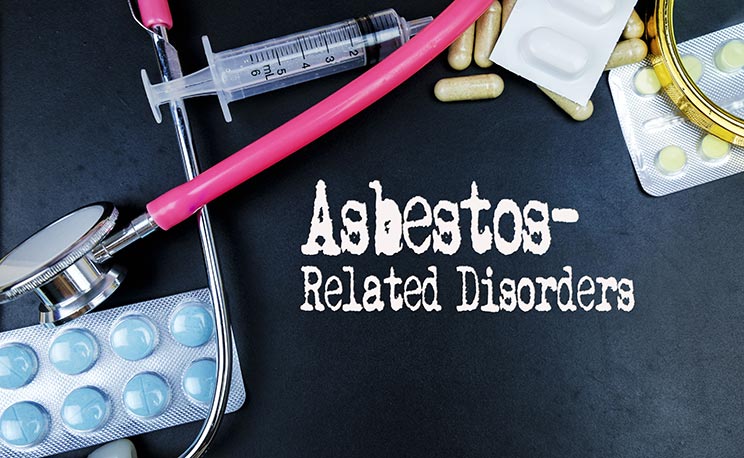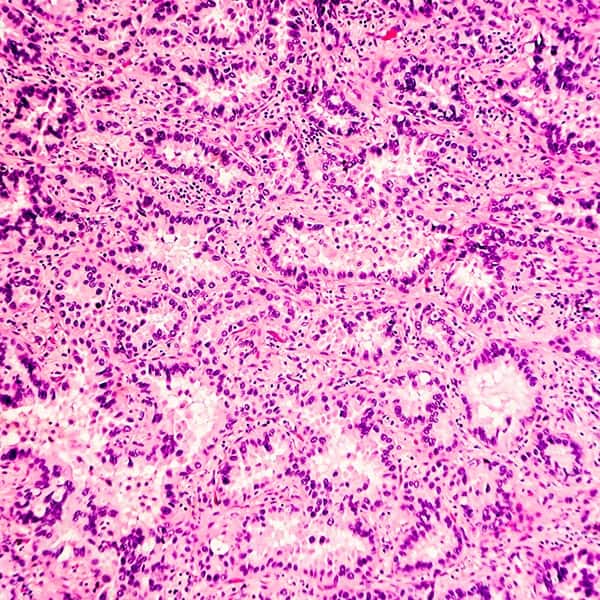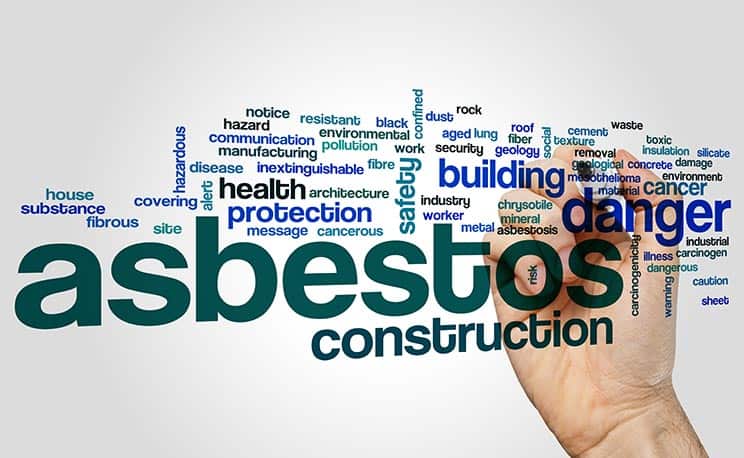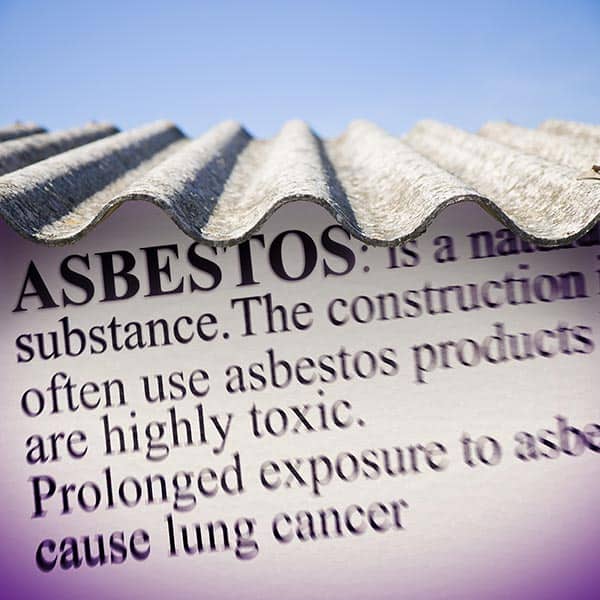How Are Asbestos Diseases Caused?
The mere presence of the toxic substance asbestos does not pose an immediate threat to anyone in its vicinity. However, asbestos fibers break down from handling or disturbances, releasing them into the air and spreading them into the environment as microscopic particles.
If ingested or inhaled, asbestos fibers can be extremely dangerous and become lodged in the body, causing mild to severe scarring and inflammation of tissue.
Significant exposure to airborne asbestos can deteriorate various bodily functions, breathing processes and provoke one or more asbestos diseases and asbestos cancers. Victims may not even be aware of the health damage asbestos exposure caused for many years; the latency period for asbestos diseases to develop can be anywhere from 10 to 50 years. Unfortunately, at this time there is no way to reverse or heal the damage caused by asbestos exposure.
Types of Asbestos Diseases
There are many adverse health effects that victims of asbestos exposure can develop. The most common asbestos injuries include asbestos respiratory diseases and asbestos lung diseases, those that disrupt normal breathing and the presence of a persistent cough. There is also an increasing amount of research linking asbestos to illnesses in other parts of the body and different types of cancers.
For decades, medical examiners and doctors have researched various illnesses, diseases, conditions, and cancers related to asbestos exposure through utilizing:
- Chest X-rays
- Pulmonary function tests (PFTs)
- High resolution and low dose computerized tomography scans (HRCTs & LDCTs)
- Bronchoalveolar lavages (BALs)
- Lung biopsies
- Physical exams

Unfortunately, there is no known cure for asbestos related diseases. Damage to the lungs or respiratory system from extended or frequent exposure to asbestos cannot be reversed. As such, treatment for patients suffering from asbestos diseases is focused on symptomatic relief and alleviating pain and suffering.
Some of the most common asbestos diseases, detailed below, include mesothelioma, asbestosis, pleural diseases and cancers of the lungs, digestive system, throat, and ovaries.
What is Mesothelioma?
According to the Centers for Disease Control and Prevention, mesothelioma is a cancer that affects membranes in the lungs, chest, abdomen, and around internal organs. Mesothelioma is almost always linked to asbestos exposure and is the most common and difficult asbestos related disease to treat. Scientific and medical data support the notion that mesothelioma is an ever prevalent disease, with more than 43,000 people worldwide receiving a mesothelioma diagnosis each year.
Mesothelioma is an extremely fatal disease with an unfortunate prognosis. Many of those diagnosed with mesothelioma do not live more than a year or two after diagnosis.
Mesothelioma Symptoms
The symptoms of mesothelioma vary based on the frequency and extent of asbestos exposure and can include:
- Chest pain
- Dry cough or frequent wheezing
- Shortness of breath
- Respiratory complications
- Fever
- Constant fatigue and muscle weakness
- Significant weight loss
To be connected with a trustworthy, compassionate, and skilled mesothelioma attorney, contact us today by calling 833-716-0087 or filling out the form below.
Asbestos Lung Cancer
According to the American Lung Association, lung cancer is the most fatal cancer among men and women in the United States, taking the lives of over 154,000 Americans in 2018 alone. This accounts for 25% of all cancer-related deaths.
This type of cancer is caused by a mutation of cells in the lungs, such as the development and subsequent growth of malignant tumors, preventing or impairing normal breathing capabilities. Cancerous tumors that originate in the lungs can spread throughout the body through blood or natural fluid in lung tissue. Patients diagnosed with lung cancer have blocked air passages which render parts of the lung incapable of breathing and more prone to infection. On average, diagnosing lung cancer as a result of asbestos ingestion occurs 15 years after exposure.
While smoking is the leading cause of lung cancer worldwide, exposure to asbestos is not far behind. Asbestos lung disease can be provoked by the inhalation of any kind of asbestos fibers and can be seriously complicated by smoking, causing more severe symptoms.
Asbestos Related Lung Cancer Symptoms
Some symptoms of asbestos related lung cancer include:
- Chronic, aggressive, and frequent coughing
- Audible hoarseness of the voice
- Coughing up blood
- Significant chest pain
- Frequent bronchitis or pneumonia
- Blood clotting

Asbestosis
Asbestosis is a non-cancerous disease, considered to be a type of pulmonary fibrosis, caused by the lodging of asbestos fibers in the internal lining of one or both lungs. Asbestos fibers can scar and inflame the lung’s lining, causing significant damage throughout the respiratory system, and gradually worsening over time.
The latency period for an asbestosis diagnosis is about 10 to 40 years. Medical research points to asbestosis as an indicator and pre-existing condition that puts patients at high risk of developing other asbestos related diseases such as mesothelioma or asbestos lung cancer. Although there is no cure for asbestosis at this time, doctors often relieve asbestosis symptoms through pulmonary rehabilitation, oxygen therapy, and procedures which remove fluid from the lungs.
Asbestosis Symptoms
Patients diagnosed with asbestosis can suffer with the following symptoms:
- Chest tightness
- Weight loss
- Hypertension
- Presence of blood in the respiratory tract
- High blood pressure
- Swelling of the neck and face
- Shortness of breath and restricted breathing
- Frequent dry cough or wheezing
- Loss of appetite
- Phalange deformity (uncommonly wide or rounded fingertips and toes)
Learn more about asbestosis here.

Asbestos Causing Pleural Plaques, Pleural Thickening and Pleural Effusion
Other common and non-cancerous consequences of asbestos exposure are pleural diseases. There are three types of pleural diseases:
- Pleural plaques: Lone, isolated areas of thickened membrane in the lungs and chest.
- Pleural thickening: The thickening or enlargement of the membrane surrounding the lungs and chest.
- Pleural effusion: The buildup of fluid in the lungs caused by membrane abnormalities.
Similar to mesothelioma, pleural diseases provoke changes in the membrane that line the lungs and chest.
Symptoms of Pleural Diseases
Common symptoms of pleural plaques, pleural thickening, and pleural effusion include:
- Difficulty breathing
- Chest pain
- Fever
- Persistent hiccups
- Chills
- Sore throat accompanied by soreness or swelling of joints
- Shortness of breath
Asbestos Causing Digestive Tract Cancers
Asbestos exposure is also a known cause of various cancers of the digestive tract, such as that of the pancreas, liver, gallbladder, colon, and rectum. In addition to asbestos ingestion, these types of cancers can be further complicated by other conditions such as obesity or chronic infection.
The severity of digestive tract cancers depends on the location of the tumor, which can slowly develop over the course of many decades. Early-stage digestive cancers generally begin in the inner lining of the stomach or intestines and can accumulate damage through growth and transformation, invading the inner walls and lining of the stomach.
Symptoms of Digestive Tract Cancers
- Loss of appetite
- Weight loss
- Significant abdominal pain and discomfort
- Frequent vomiting and nausea
- Bloating
- Fatigue
- Heartburn
Asbestos Causing Stomach Cancer
Research on asbestos has led scientists and medical specialists to believe that prolonged exposure to asbestos can increase the risk of developing stomach cancer, also referred to as peritoneal mesothelioma.
Asbestos Causing Rectal Cancer
Medical research suggests asbestos inhalation and ingestion through contaminated food or water sources can lead to cancer throughout the rectum. Being obese, a heavy smoker, having a family history of rectal cancer, and having type 2 diabetes put those who are exposed to asbestos at a higher risk of contracting rectal cancer.
Asbestos Causing Throat Cancers: Laryngeal Cancer and Pharyngeal Cancer
When asbestos is inhaled, fibers can become lodged in the throat before making their way into the lungs or chest cavities. For this reason, there is significant research dedicated to investigating the link between asbestos and cancer of the throat, such as that of the larynx and pharynx.

Asbestos Related Throat Cancer Symptoms
Although symptoms are often mild and sometimes absent, patients diagnosed with throat cancer can suffer from:
- Coughing
- Vocal changes
- Sore throat
- Development of lumps and sores
- Difficulty swallowing
- Constant and debilitating ear pain
Asbestos Causing Laryngeal Cancer
Laryngeal cancer affects the lower part of the throat – anywhere from the tongue to the trachea. This is a cartilage-rich area of the throat that plays a significant role in breathing, speaking and swallowing as it contains the tonsils and vocal cords.
Asbestos Causing Pharyngeal Cancer
The pharynx affects the upper part of the throat – anywhere from the top of the trachea to the top of the windpipe. Pharyngeal cancer is usually diagnosed if there is an abnormal, yet often painless, lump in the upper neck.
Asbestos Related Ovarian Cancer
Asbestos is increasingly linked to the development of ovarian cancer in women. Initially thought to be the result of a misclassification of cancerous tumors, scientific research now points to asbestos exposure negatively affecting female reproductive organs. Ovarian cancer is difficult to detect and even more difficult to treat, where surgery and chemotherapy are the most common.
Ovarian Cancer Symptoms
Symptoms of ovarian cancer include:
- Consistent swelling or bloating in the abdomen
- Overall discomfort in the pelvic area
- Frequent urges to urinate
- Changes in digestive habits
If you or a loved one has been diagnosed with any of the asbestos diseases listed above, The Law Center can help. Contact us by calling 833-716-0087 or filling out the form below to be connected with a premier asbestos attorney who will fight on your behalf to seek justice and obtain compensation for the suffering you endure, which was preventable.
How Can You Prevent an Asbestos Related Disease?
The best prevention for asbestos diseases is to limit exposure through eliminating or reducing the use of consumer or commercial asbestos products. There are many laws and regulations put in place to protect workers and consumers from the adverse health effects of toxic asbestos exposure. Though limited, asbestos is not completely banned in the United States, causing asbestos use to continue to be ongoing and widespread.
Without completely abandoning asbestos products, there are ways to reduce the risk of contracting asbestos related diseases. Using water to moisten areas thought to contain damaged asbestos can eliminate ingestion, as asbestos is commonly inhaled in dry environments. Using protective gear such as a respirator, goggles and gloves can also decrease the risk of asbestos inhalation and ingestion. When renovating or engaging in construction or demolition in an older building, it is recommended to have the area inspected for asbestos deposits by a trained asbestos specialist.

Legal Help for Asbestos Diseases
Victims of asbestos exposure that are diagnosed with an asbestos related disease do not have to endure their suffering alone. There are many specialized asbestos law firms and legal practitioners who are focused on helping victims rectify irresponsible asbestos exposure.
Over the years, many trust funds have been created by negligent contract employers and asbestos manufacturers who reserve and allocate financial resources for victims of asbestos diseases. Hiring an experienced asbestos attorney can help facilitate access to these funds as well as obtaining damages through asbestos lawsuits.
Environmental Litigation Group (ELG)
Asbestos lawsuits against manufacturers, commercial entities and contract employers for their negligence regarding asbestos exposure constitute the longest running tort in the United States. One firm with noteworthy success through their dedication and coordinated approach is the Environmental Litigation Group. ELG’s expert team has an accumulated 20 years of experience, has represented thousands of clients, filed over 233,000 claims, and recovered $1.4 billion in settlements for asbestos patients and their families.
The Law Center
If you or someone you know has been subjected to extended asbestos exposure that has resulted in a diagnosis of one or more of the aforementioned asbestos related diseases, you may be entitled to compensation to offset medical costs, as well as pain and suffering.
You can find out if you are eligible to bring an asbestos lawsuit or are entitled to compensation from an asbestos trust by contacting The Law Center for a free case evaluation. Partnering with a strong national network of distinguished law firms and legal practitioners, like ELG, The Law Center can help connect you to an expert asbestos attorney who can take on your case and fight on your behalf for justice and maximum compensation.
Sources
- https://www.atsdr.cdc.gov/docs/limitingenvironmentalexposures_factsheet-508.pdf
- https://www.atsdr.cdc.gov/asbestos/health_effects_asbestos.html
- https://www.atsdr.cdc.gov/asbestos/docs/Asbestos_Factsheet_508.pdf
- https://www.who.int/bulletin/volumes/89/10/11-086678/en/
- https://www.cancer.org/cancer/cancer-causes/asbestos.html
- https://www.lung.org/lung-health-diseases/lung-disease-lookup/lung-cancer/resource-library/lung-cancer-fact-sheet
- https://my.clevelandclinic.org/health/treatments/16611-laryngeal-cancer-care-path
- https://patient.info/doctor/pharyngeal-cancer
- https://ehp.niehs.nih.gov/doi/full/10.1289/ehp.1003283
- https://www.mayoclinic.org/diseases-conditions/ovarian-cancer/symptoms-causes/syc-20375941
- https://www.bmc.org/pleural-diseases
- https://www.healthline.com/health/pleural-effusion#treatment
- https://www.healthline.com/health/gastric-cancer